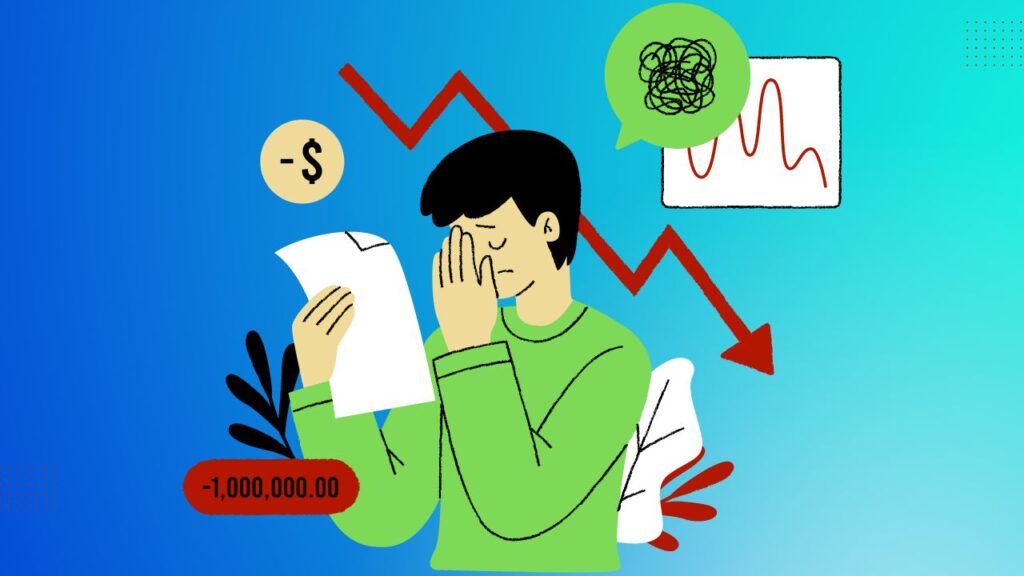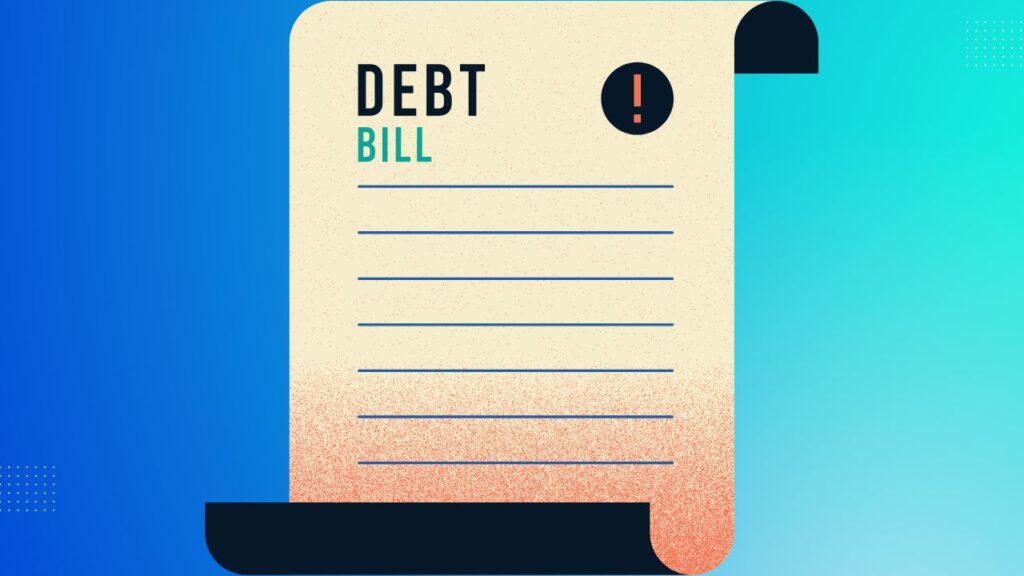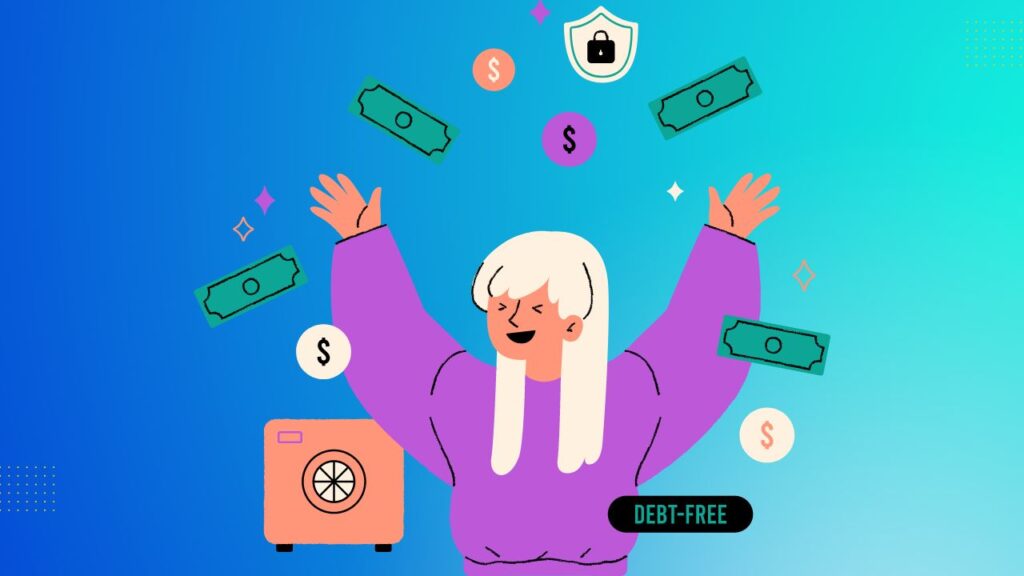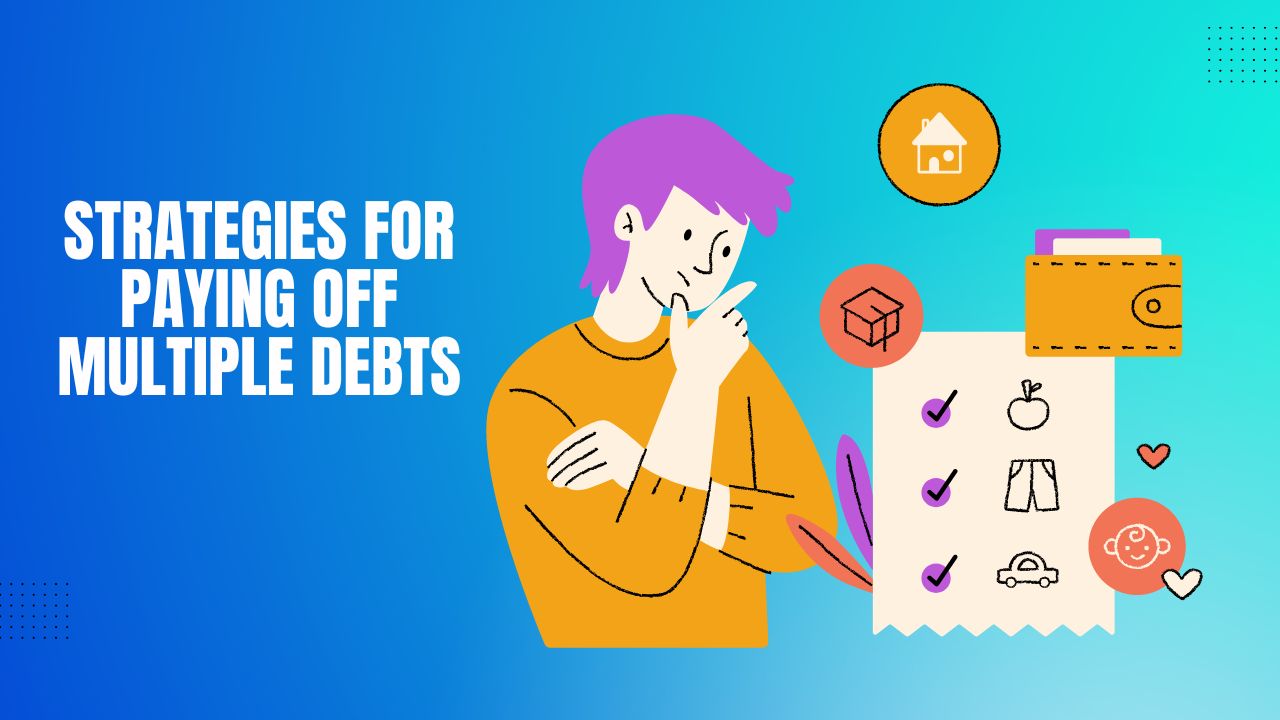Let’s talk about a topic that is on everyone’s mind – debt!
Did you know that the average millennial has over $23,000 in debt?
According to a study by Northwestern Mutual, 45% of millennials have credit card debt and 40% have student loan debt.
That’s a significant number, and it’s not something to be taken lightly. Being in debt can be a major source of stress and can impact your financial future in a big way.
But don’t worry, you’re not alone.
In this article, we’ll be discussing debt-free living and the proven strategies for paying off multiple debts.
We’ll cover everything from understanding your debt to creating a budget, choosing the right debt payoff strategy, and tips for staying motivated throughout the process.
By the end of this post, you’ll have all the tools you need to take control of your finances and start living a debt-free life.
So grab a cup of coffee, sit back, and let’s get started on our journey toward financial freedom!
1. Understanding Your Debt

When it comes to paying off your debts, the first step is to understand exactly what you owe.
This may seem overwhelming, but it’s crucial to get a clear picture of your financial situation.
By assessing your debt, you’ll be able to create a plan that works for you and start taking action toward becoming debt-free.
1.1 Assessment of Your Debt
1.1.1 Listing Out All of Your Debts
The first step in assessing your debt is to list out all of your debts.
This includes credit cards, student loans, car loans, and any other debts you may have.
Write down the name of the creditor, the amount owed, and the interest rate. It’s important to be as detailed as possible so that you don’t miss anything.
To make it easier, you can use a spreadsheet or table to organize your debt. Here’s an example:
| Creditor | Amount Owed | Interest Rate |
| Credit Card 1 | $5,000 | 18% |
| Credit Card 2 | $3,000 | 22% |
| Student Loan | $20,000 | 6% |
| Car Loan | $15,000 | 4% |
1.1.2 Determining Interest Rates and Minimum Payments
Once you have a list of all of your debts, it’s important to determine the interest rates and minimum payments for each one.
Interest rates can vary greatly, and it’s important to know which debts are costing you the most money in interest.
The minimum payment is the amount you’re required to pay each month to avoid late fees and penalties.
It’s important to know the minimum payment for each debt so that you can budget accordingly.
Again, you can use a table to organize this information. Here’s an example:
| Creditor | Amount Owed | Interest Rate | Minimum Payment |
| Credit Card 1 | $5,000 | 18% | $100 |
| Credit Card 2 | $3,000 | 22% | $75 |
| Student Loan | $20,000 | 6% | $200 |
| Car Loan | $15,000 | 4% | $300 |
Now that you have a clear understanding of your debts, you can start creating a plan to pay them off.
It’s important to prioritize your debts based on interest rates and minimum payments, and we’ll discuss this further in the next section.
1.2 Explanation of the Types of Debt
Understanding the different types of debt you may have is important for creating a plan to pay off your debts efficiently.
Let’s look at the most common types of debt and provide some helpful tips for managing them.
1.2.1 Credit Card Debt
Credit card debt is one of the most common types of debt among millennials.
According to a study by Experian, the average credit card debt for millennials is $4,712. Credit card debt can be particularly challenging to pay off because of high-interest rates.
To manage credit card debt, it’s important to make more than the minimum payment each month and to avoid using your credit card for unnecessary purchases.
Consider using a balance transfer credit card with a low or 0% interest rate to consolidate your credit card debt and save on interest.
1.2.2 Student Loan Debt
Student loan debt is another common type of debt among millennials.
According to the Federal Reserve, the total amount of student loan debt in the U.S. is over $1.7 trillion, with the average borrower owing $32,731.
To manage student loan debt, consider enrolling in an income-driven repayment plan, which can lower your monthly payments based on your income.
You can also consider refinancing your student loans to potentially lower your interest rate and save money over time.
1.2.3 Car Loan Debt
Car loan debt is another type of debt that many millennials may have. According to Experian, the average car loan balance for millennials is $18,201.
To manage car loan debt, it’s important to make your monthly payments on time and consider paying more than the minimum payment each month to pay off the loan faster.
You can also consider refinancing your car loan to potentially lower your interest rate and save money over time.
1.2.4 Mortgage Debt
Mortgage debt is a type of debt that many millennials may have as they purchase their first home.
According to a study by Bank of America, 72% of millennials are considering buying a home in the next five years.
To manage mortgage debt, it’s important to make your monthly payments on time and consider paying more than the minimum payment each month to pay off the loan faster.
You can also consider refinancing your mortgage to potentially lower your interest rate and save money over time.
By understanding the different types of debt you may have, you can start creating a plan to manage your debts and pay them off efficiently.
2. Choosing the Right Debt Payoff Strategy

2.1 Snowball Method
The snowball method is a popular debt payoff strategy that involves focusing on paying off your smallest debts first and then moving on to your larger debts.
2.1.1 How It Works
First, list out all of your debts from smallest to largest. Then, make the minimum payment on all of your debts except for the smallest one.
Put any extra money you have towards paying off the smallest debt until it’s completely paid off.
Once the smallest debt is paid off, take the money you were putting towards that debt and apply it to the next smallest debt.
Continue this process until all of your debts are paid off.
For example, let’s say you have three debts:
- Credit card debt: $2,500 with a minimum payment of $50/month
- Student loan debt: $10,000 with a minimum payment of $150/month
- Car loan debt: $15,000 with a minimum payment of $300/month
Using the snowball method, you would focus on paying off the credit card debt first, making the minimum payment on the student loan and car loan.
Once the credit card debt is paid off, you would then focus on the student loan, and then the car loan.
2.1.2 Pros and Cons
Pros:
- Can provide a sense of accomplishment and motivation as you pay off smaller debts first
- Can help you build momentum toward paying off larger debts
- Can simplify the debt payoff process by focusing on one debt at a time
Cons:
- May not be the most cost-effective method as you may be paying more in interest on larger debts while focusing on smaller debts
- May not work as well for those with larger debts or high-interest rates
- May take longer to pay off all of your debts compared to other strategies
Overall, the snowball method can be a great option for those looking for motivation and a simple debt payoff process.
However, it’s important to weigh the pros and cons and determine if it’s the right strategy for your situation.
2.2 Avalanche Method
The avalanche method is another popular debt payoff strategy that involves focusing on paying off your highest interest-rate debts first and then moving on to your lower-interest-rate debts.
2.2.1 How It Works
First, list out all of your debts from highest to lowest interest rate.
Then, make the minimum payment on all of your debts except for the one with the highest interest rate.
Put any extra money you have towards paying off the debt with the highest interest rate until it’s completely paid off.
Once the highest interest rate debt is paid off, take the money you were putting towards that debt and apply it to the next highest interest rate debt.
Continue this process until all of your debts are paid off.
For example, let’s say you have three debts:
- Credit card debt: $2,500 with an interest rate of 18% and a minimum payment of $50/month
- Student loan debt: $10,000 with an interest rate of 6% and a minimum payment of $150/month
- Car loan debt: $15,000 with an interest rate of 4% and a minimum payment of $300/month
Using the avalanche method, you would focus on paying off the credit card debt first, making the minimum payment on the student loan and car loan.
Once the credit card debt is paid off, you would then focus on the student loan, and then the car loan.
2.2.2 Pros and Cons
Pros:
- Can save you more money in interest in the long run as you focus on paying off high-interest-rate debts first
- May help you pay off your debts faster compared to other strategies
- Can be more cost-effective overall
Cons:
- May not provide as much motivation or a sense of accomplishment as you may not see quick results early on
- May be more complex than the snowball method as you need to factor in interest rates and balances
- May not work as well for those with low interest-rate debts or those with a large number of debts
Overall, the avalanche method can be a great option for those looking to save money on interest and pay off their debts faster.
However, it’s important to weigh the pros and cons and determine if it’s the right strategy for your situation.
2.3 Debt Consolidation
2.3.1 How it works
Debt consolidation is the process of combining all your debts into one loan with a lower interest rate.
Instead of paying multiple creditors each month, you make a single payment to the consolidation company.
This company then pays off your existing debts on your behalf, and you repay the consolidation loan over a set period.
There are two main types of debt consolidation: secured and unsecured.
A secured debt consolidation loan requires you to provide collateral, such as your home or car, which the lender can seize if you default on your payments.
An unsecured debt consolidation loan, on the other hand, doesn’t require collateral but typically comes with a higher interest rate.
2.3.2 Pros and cons
Pros:
- Simplifies your monthly payments: By consolidating your debts, you only have to make a single monthly payment instead of multiple payments to different creditors.
- Lowers your interest rates: Debt consolidation companies can negotiate with creditors on your behalf to lower your interest rates, which can save you money in the long run.
- Improves your credit score: Debt consolidation can help improve your credit score by reducing your credit utilization ratio and making your payments more consistent.
- Provides a clear debt repayment plan: Debt consolidation companies typically provide a clear repayment plan that outlines when you’ll be debt-free.
Cons:
- Doesn’t eliminate your debt: Debt consolidation doesn’t eliminate your debt; it simply combines it into one loan. You still owe the same amount of money, and if you don’t change your spending habits, you could end up in even more debt.
- Requires discipline: Debt consolidation requires discipline to avoid taking on more debt and making consistent payments on the consolidation loan.
- Can be costly: Some debt consolidation companies charge high fees or interest rates, which can add up over time and make your debt even more difficult to repay.
- Can impact your credit score: Applying for a debt consolidation loan can temporarily lower your credit score, and if you miss payments or default on the loan, it can hurt your credit score.
3. Creating a Budget

3.1 Importance of creating a budget
Creating a budget is the foundation of managing your finances and achieving financial freedom.
By creating a budget, you can get a clear picture of your income, expenses, and debt obligations.
A budget helps you prioritize your spending, identify areas where you can cut back, and make a plan to pay off your debts efficiently.
Moreover, having a budget can help you build better financial habits and avoid unnecessary debt in the future.
3.2 Steps to Create a Budget
- Listing out all sources of income: The first step to creating a budget is to determine your total income. This can include your salary, freelance income, side hustles, and any other sources of income. Make a list of all your income sources and calculate the total amount.
- Listing out all expenses: Next, you need to list out all your expenses, including fixed expenses such as rent, utilities, and car payments, as well as variable expenses such as groceries, dining out, entertainment, and other discretionary spending. Make sure to include your minimum debt payments in your expenses list.
- Cutting back on unnecessary expenses: Once you have a clear picture of your income and expenses, you can start cutting back on unnecessary expenses. Identify areas where you can cut back, such as eating out less, canceling subscriptions you no longer use, or reducing your utility bills. By reducing your expenses, you can free up more money to pay off your debts efficiently.
- Creating a debt repayment plan: Once you have identified areas to cut back on, you can create a debt repayment plan using one of the debt payoff strategies discussed earlier. Allocate your extra money towards the debt with the highest interest rate or smallest balance, depending on which strategy you choose. Make sure to continue making minimum payments on all your debts to avoid late fees and penalties.
3.3 Recommended Budgeting Apps for Millennials
There are many budgeting apps available that can help you create and manage your budget.
Some popular options for millennials include Mint, Personal Capital, YNAB (You Need A Budget), and PocketGuard.
These apps can help you track your expenses, monitor your debt payoff progress, and stay on top of your financial goals.
Choose an app that fits your needs and start taking control of your finances today.
4. Tips for Paying Off Debt

4.1 Increase your income
A key aspect of paying off multiple debts efficiently is finding ways to increase your income.
By earning more money, you can put more towards paying down your debts and reach your financial goals faster.
Here are some tips for increasing your income:
- Finding a side hustle: A side hustle is a great way to earn extra income on top of your regular job. There are countless options for side hustles, from delivering food or packages to freelancing or tutoring. Look for opportunities that match your skills and interests, and don’t be afraid to try something new.
- Asking for a raise: If you’re currently employed, asking for a raise is one way to increase your income. Research what others in your field and position are earning and come up with a compelling argument for why you deserve a higher salary. It can be nerve-wracking to ask for a raise, but it’s worth it if it means more money in your pocket.
- Selling items you no longer need: Another way to earn extra cash is by selling items you no longer need. This could include clothing, electronics, furniture, or anything else you have lying around that you no longer use. You can sell items online through sites like eBay or Facebook Marketplace, or have a yard sale or garage sale.
By increasing your income, you’ll have more money to put towards paying off your debts, and you’ll be able to reach your financial goals faster.
4.2 Cut back on expenses
When it comes to paying off debt, cutting back on expenses can be just as effective as increasing your income.
It may seem difficult to cut back on expenses at first, but it’s a crucial step toward becoming debt-free.
Here are some tips for cutting back on expenses:
- Eating out less: Eating out can be a significant expense, especially if you do it frequently. Consider cooking at home more often and bringing your lunch to work instead of eating out every day. This small change can save you hundreds of dollars each month.
- Using coupons and discounts: When shopping for groceries or other necessities, make sure to check for coupons and discounts that you can use. Many stores offer digital coupons that you can load onto your loyalty card, and several apps can help you find coupons and deals.
- Cutting back on subscriptions: With so many subscription services available these days, it’s easy to sign up for more than you need. Take a look at your subscriptions and cancel any that you don’t use or that aren’t necessary. For example, do you need subscriptions to multiple streaming services or a gym membership that you hardly use?
By cutting back on these expenses, you can free up more money to put towards paying off your debt.
Remember, every little bit helps!
4.3 Staying Motivated
When it comes to paying off debt, staying motivated can be a challenge, especially if you have multiple debts and a long road ahead.
However, there are several ways to keep yourself motivated throughout the process.
- Celebrating milestones: It’s important to acknowledge and celebrate the progress you make along the way. Every time you pay off a debt or hit a savings goal, take a moment to acknowledge your hard work and treat yourself to something you enjoy, such as a nice meal or a fun activity.
- Surrounding yourself with supportive people: Having a strong support system can make all the difference when you’re trying to pay off debt. Seek out friends and family members who will encourage you and cheer you on along the way. You may even want to consider joining a support group or online community of people who are also working to pay off debt.
- Keeping track of progress: Finally, it’s important to track your progress and celebrate your successes along the way. Keep a record of your debt payoff journey, whether it’s in a spreadsheet or a journal. This will help you see how far you’ve come and remind you that you’re making progress, even if it feels slow at times.
Remember, paying off debt is a marathon, not a sprint. It takes time and effort, but with the right strategies and mindset, it’s achievable.
By staying motivated and committed to your goal, you’ll be able to achieve debt-free living in no time.
5. Staying Debt-Free

5.1 Tips for avoiding debt in the Future
Being debt-free is a great accomplishment, but staying debt-free is just as important.
To help you stay on track, here are some tips for avoiding debt in the future:
- Creating an emergency fund: Having an emergency fund can help you avoid going into debt when unexpected expenses arise. Experts suggest saving at least 3 to 6 months’ worth of living expenses in an emergency fund.
- Avoiding unnecessary purchases: It’s important to distinguish between wants and needs. Before making a purchase, ask yourself if it’s something you truly need or just something you want. Consider waiting a few days before purchasing to see if it’s really necessary.
- Using credit responsibly: Credit can be a helpful tool when used responsibly. Make sure to pay off your credit card balances in full each month to avoid interest charges. Only charge what you can afford to pay off at the end of the month. Keep your credit utilization ratio below 30% to maintain a good credit score.
Research has shown that millennials are more likely to carry credit card debt than other generations.
A 2021 survey by Credit Karma found that 58% of millennials have credit card debt, with an average balance of $6,129.
Creating a plan to pay off credit card debt and using credit responsibly can help prevent future debt.
In addition to these tips, it’s important to continue to educate yourself about personal finance and make it a priority in your life.
By staying informed and making smart financial decisions, you can continue to live a debt-free lifestyle.
5.2 Importance of financial planning
Financial planning is an essential part of staying debt-free. It involves creating financial goals, saving for retirement, and investing wisely.
Here are some tips to help you with financial planning.
5.2.1 Creating Financial Goals
It is crucial to set financial goals that align with your long-term plans. Write down your goals and create a plan to achieve them.
Consider the following goals:
- Paying off all debts
- Building an emergency fund
- Saving for a down payment on a house
- Investing for retirement
- Saving for your child’s education
- Starting your own business
5.2.2 Saving for Retirement
Retirement may seem far away, but it is never too early to start saving for it. The earlier you start, the more time your investments have to grow.
Consider the following tips:
- Start contributing to a retirement account as soon as possible, such as a 401(k) or an IRA
- Take advantage of employer-matching contributions
- Increase your contribution rate as you get older or receive salary increases
- Consider the risks and potential returns of different investment options
5.2.3 Investing wisely
Investing is a great way to grow your money, but it comes with risks.
Here are some tips for investing wisely:
- Diversify your portfolio by investing in different types of assets, such as stocks, bonds, and real estate
- Consider working with a financial advisor to help you create an investment strategy
- Regularly review and adjust your investments based on market performance and changes in your financial goals
By creating financial goals, saving for retirement, and investing wisely, you can stay on track and avoid falling back into debt.
It’s important to remember that financial planning is an ongoing process, and you may need to adjust your goals and strategies as your life circumstances change.
Bottom Line…
In conclusion, paying off multiple debts can be a daunting task, but with the right strategies and mindset, it is possible to achieve debt-free living.
We have discussed various proven debt payoff strategies, including the snowball and avalanche methods, as well as debt consolidation.
Additionally, we have highlighted the importance of creating a budget and provided steps and recommended budgeting apps for millennials.
Tips for increasing income, cutting back on expenses, and staying motivated throughout the debt payoff journey have also been shared.
It is important to note that staying debt-free requires long-term commitment and financial planning.
Building an emergency fund, avoiding unnecessary purchases, and using credit responsibly are essential steps for avoiding debt in the future.
Furthermore, creating financial goals, saving for retirement, and investing wisely is crucial for achieving financial stability and security.
Remember, achieving debt-free living is not just about paying off debts but also about building a healthy relationship with money.
By following the strategies and tips outlined in this post, millennials can take control of their finances and work towards a debt-free and financially stable future.

5 thoughts on “Debt-Free Living: The Proven Strategies for Paying Off Multiple Debts”